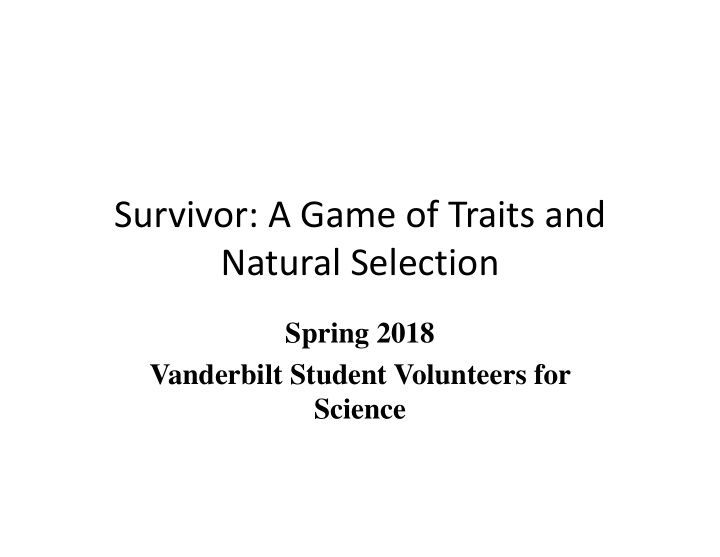



Survivor: A Game of Traits and Natural Selection Spring 2018 Vanderbilt Student Volunteers for Science
I. Introduction • Why is Charles Darwin so important? – Concluded that organisms changed over time to better survive in their specific environments. • “I have called this principle, by which each slight variation, if useful, is preserved, by the term Natural Selection.” ‐ Charles Darwin, On the Origin of Species
Why is the science in this lesson important? As its name implies, natural selection happens in nature without human interference, but a similar process called artificial selection still relies on the same principles. A rancher in Arizona is breeding his cattle to consume less grass yet still produce more beef. Plants have been bred to create bigger and sweeter fruits. Humans are able to control the prevalence of traits by increasing the fitness of desired traits with selective breeding.
IA. Traits Traits are the physical characteristics you have • – Differ between organisms – Influenced by your genes and environment • Height and weight are determined by genes and what we eat Traits naturally have different forms, called variations, caused by differing • genes Traits can be passed to offspring • Ex. Skin color, eye color, left/right handed –
IB. Natural Selection Some organisms have traits that allow them to better survive in their environment. • The organisms that manage to survive then reproduce, passing on the genes for their advantageous traits to their offspring. If a gene leads to a trait that gives a significant enough advantage to the organism, • then the organisms with that gene will eventually out ‐ populate those without the gene This is why people describe the theory of natural selection as “the survival of the • fittest”. – Ex. Peppered Moths
IC. Adaptations • Adaptation is an inherited trait that helps organisms survive • This enables organisms to survive certain environments • Ex. Rosebush thorn, lizards tails falling off
II. Making the creatures Learning Goals: Students make creatures with specific genetic variation and see how simple variation can lead to drastically different levels of survival. Look at list of traits as a class and discuss the benefits and • detriments for the first trait ‐ Leg Length Trait Variation Beneficial for: Detrimental for: Leg Length Long Can run fast Cannot hide in grassland Short Can hide in grassland Cannot run very fast Each group decides which Trait variation their creature will have • Have groups circle variation and give reason for choosing it •
II. Making the creatures (cont.) • Rules of building creature: – Creatures can have only ONE variation of a Trait – Groups cannot change their creature after game begins • After creatures are made, pass out SURVIVOR Student Handbook worksheet
III. Survivor Game Learning Goals: Students make creatures with specific genetic variation and see how simple variation can lead to drastically different levels of survival. All teams start with no chips. • Scenarios will be read in order by VSVS • members (in manual) – Students will receive a green chip when their creature successfully reproduces, and a red chip when it does not. – At the end of the game, those with more red chips than green chips have gone extinct, while those with more green chips than red chips will live on.
IV. What creatures Survived? Students pair up red chip with a green chip. Have students set aside paired • chips to get their final “score” from the remaining chips Final scores will be written on board by VSVS member • Tell students that if a creature is holding only red chips, it has gone extinct • Creatures with only green chips survived and reproduced • Final # and color of chips Creature 1 Creature 2 Creature 3 Creature 4 Etc…
Which variations were best? Ask students why some traits were more helpful than others • – “creatures” went extinct if their traits were not advantageous in the environment Have students with green chips bring their creatures to the front, so the • whole class can see – Have students determine if there are 2 ‐ 3 common traits among survivors Have students with creatures that have gone extinct come to the front of • class. – Determine if there are 2 ‐ 3 common traits among those who went extinct
Review Concepts • Explain that the students simulated natural selection • Ask students which creatures will be best suited in the future – Creatures whose traits are selected will pass their traits on
Conclusion Questions • What is a trait? – See packet for answers • By what is a trait influenced? • What is natural selection? • How does natural selection work? • How does environment influence survival? • What is an adaption?
Recommend
More recommend